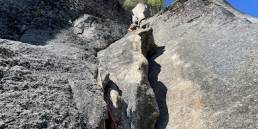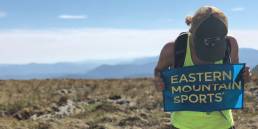In the summer of 2023, my husband, our dog, Rocky, and I went on an epic cross-country road trip adventure, traversing the diverse landscapes of the United States. We traveled in a Toyota Tundra with a rooftop tent and explored the hidden gems, charming towns, and breathtaking vistas that make America a land of endless beauty and adventure.

Photography Tips for Documenting Your Dog-Friendly Road Trip
Setting out on a road trip across the United States with your furry companion is an unforgettable adventure filled with endless opportunities for exploration and discovery. As you journey through picturesque landscapes and charming towns, capturing these precious moments with photography is a cherished way to preserve memories for years to come.
Below you’ll find some photography tips tailored specifically for documenting your dog-friendly road trip and ensuring that every moment is beautifully captured.
Before Your Trip
Before setting out on a trip with your dog, practice their sit and stay commands at home. Additionally, consider teaching them fun tricks such as a high-five, balancing treats on their nose, or ‘selfie/hug’ in a familiar environment before testing their skills amidst new distractions. Even if your dog doesn’t know a lot of commands yet, just be patient and go with the flow. Authentic photos are the best photos!
Of course, before hitting the road, you’ll want to make sure you have all the necessary photography gear, including your camera or smartphone, spare batteries, memory cards, tripod (perfect if you and your dog are traveling alone; after all, you both want to be in the photos), and a bag to protect and carry your equipment during outdoor adventures.

During Your Trip
Don’t be shy about snapping numerous pictures of your dog in various poses and settings. The beauty of digital photography is the ability to take an abundance of shots without worrying about film. By capturing a multitude of images, you increase the likelihood of capturing that perfect moment or expression. Remember, you can always sift through the photos later to discover hidden gems that may not have initially stood out. Quantity often leads to quality in pet photography!
Pet Photography Camera Settings
Sure you can just point and shoot, but understanding and using your camera’s settings is a great step toward taking stellar photos. Below are a few basics to master before setting out on your adventure.
ISO and Exposure: The ISO is your camera’s sensitivity to light. Exposure is the brightness or darkness of a photograph. The lower the ISO number, the less sensitive the camera is to light while the higher the ISO number, the more sensitive the camera is to light. If your whites are too bright, your image is overexposed. If your blacks are too dark, it’s underexposed, so play with your ISO, aperture, and shutter speed. If you’re using a smartphone, the phone will likely do the work for you!
Aperture and Depth of Field: Aperture controls the amount of light entering the camera lens, affecting both depth of field and the sharpness of your image. Depth of field is how much of your image is in focus. A deep depth of field indicates that the foreground, subject, and background are in focus. A shallow depth of field is when just the subject is in focus and the background is blurred, which I prefer.
Shutter Speed—Portraits & Action Shots: Shutter speed determines how long the camera’s shutter remains open, capturing motion or freezing action in a photograph; 1/250 is best for portraits and a much higher shutter speed is best for action shots.

5 Tips to Get the Best Shots of Your Dog
1. Capture Your Dog’s Attention
Encourage natural and engaging expressions by bringing along your dog’s favorite treats or toys to capture their attention during photoshoots. Hold a treat or your dog’s favorite toy near the camera, to motivate them to focus on you!
Squeaky toys work really well—in fact, the plastic squeaker from inside a dog toy is easy to carry in your pocket and squeak for attention. When you use it to get a good shot, have a treat ready to give your pup as a reward. Don’t have a squeaker? Try making unusual sounds, like whistling or smooching noises. Using apps or YouTube videos that feature strange animal noises or dog whistles is another great way to get your pup to focus on you (and the camera).
Another trick is vocalizing your dog’s name—for example: Rocky, are you a good boy?—or using favorite words, like treat or walk, to encourage them to make eye contact, possibly accompanied by a head tilt, which, in my view, makes for good photos.
2. Tire Your Pup Out
Before you start a photo session, take your furry friend for an energetic walk or play a game of fetch. This not only helps to burn off excess energy but also increases their tolerance for sitting still and posing for photos. Additionally, a happily panting pup gives the impression that they are smiling.
3. Capture Candid Moments
Some of the most memorable photographs are candid shots that capture your dog’s playful antics, curious expressions, and heartwarming interactions with their surroundings. Always keep your camera ready to capture these natural moments of joy and freedom.
4. Embrace Natural Light
Take advantage of the soft, flattering light during the golden hours of sunrise and sunset for stunning outdoor portraits of your furry companion. Position your dog facing the light to avoid harsh shadows and capture their features in exquisite detail.
5. Get Down to Their Level
Get down to your dog’s eye level to capture their perspective. This helps create a more intimate connection in the photo.
Experimenting with different angles is another way to add interest and variety to your shots. Here are some cool angles to try:
- Overhead Shots: Stand or climb above your dog to capture unique overhead views (particularly effective when they’re lying down or playing).
- Close-Ups: Zoom in on specific features like their eyes, nose, or paws to capture detail and expressiveness.
- Action Shots: Capture your dog in motion, whether running, jumping, or playing fetch, to convey their energy and enthusiasm. When shooting action shots, have a higher shutter speed (or burst mode), at least 1/250 of a second, but likely much higher depending on other features like lighting.
- Environmental Shots: Include elements of your dog’s surroundings to provide context and tell a story about their adventures.
- Silhouette Shots: Position your dog against a bright background or light source to create striking silhouette images.
- Reflection Shots: Capture your dog’s reflection in water or shiny surfaces for a creative twist on traditional portraits.
- Low-Angle Shots: Shoot from a low perspective, looking up at your dog, to emphasize their size and stature.
- Frame Within a Frame: Use natural frames like doorways, windows, or foliage to frame your dog within the composition, adding depth and visual interest.
- Symmetrical Shots: Position your dog centrally in the frame with symmetry in mind, creating visually pleasing and balanced compositions.
Experimenting with these angles can help you discover new perspectives and capture memorable moments of your furry friend. Remember to be patient and have fun while photographing your dog!

A Picture-Perfect Pet-Friendly Road Trip
As you set out on your dog-friendly road trip, remember that the journey is as precious as the destination. By following these photography tips and embracing the spontaneity and joy of traveling with your furry companion, you’ll create a timeless collection of memories that celebrate the bond between you and your beloved dog. So, pack your camera, leash up your pup, and enjoy an unforgettable adventure filled with love, laughter, and countless photo-worthy moments.
Happy travels!
Alyx Braunius
Alyx is a New York native who embraces wholesome living through immersive experiences in nature and travels around the world. As a global explorer, she has connected with diverse cultures, people, and places, all while sharing her insights and discoveries through her travel and wellness blog The Healthy Livin Travelers.
Related Posts
November 28, 2023
A goEast Guide to Giving Tuesday in New England
New England communities and causes to…
July 5, 2023
EMS Seeks the Peak: Q+A with Team Captain Heather Patterson
EMS traveling manager, Heather…

















